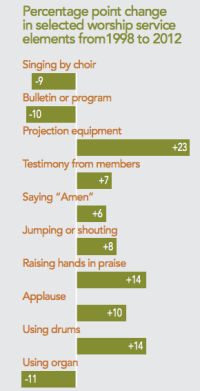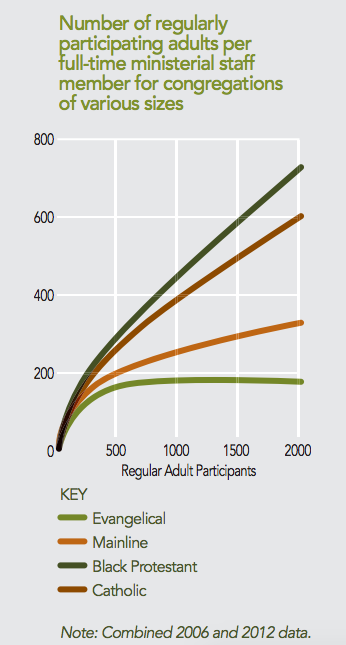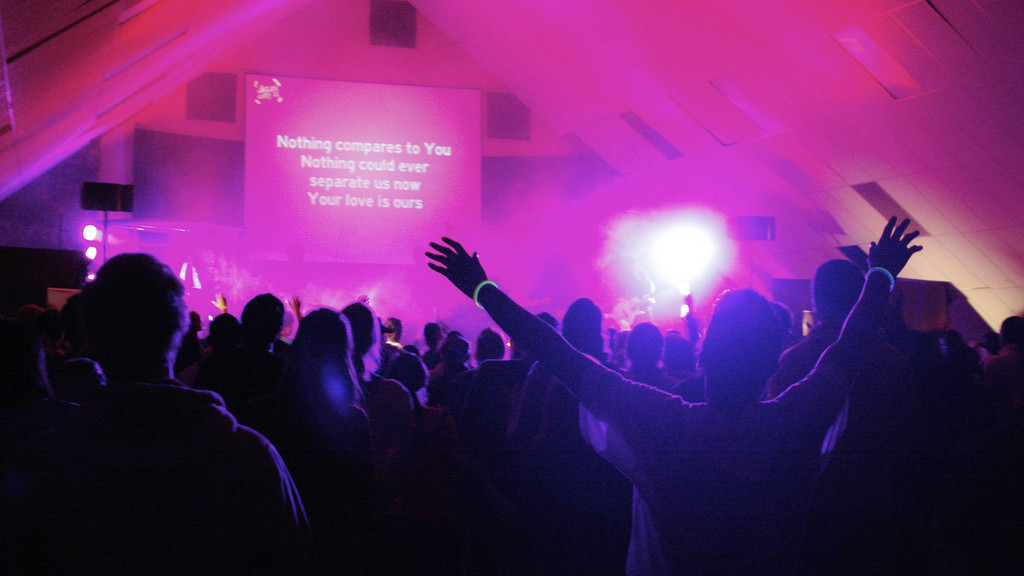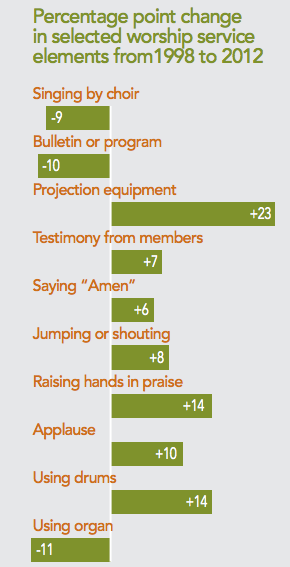Out: Organs, bulletins, and choirs.
In: Spoken amens, raising hands during worship, and using projection equipment for song lyrics and sermon notes.
This change to the American church is deeper than just a formality swap, said the authors of the latest National Congregations Study (NCS).
Instead, it’s part of a “decades-long trend in American religion away from an emphasis on belief and doctrine and toward an emphasis on experience, emotion, and the search for a least-common-denominator kind of worship in a time of ever less salient denominationally specific liturgical and theological content,” wrote the authors of the latest wave of the three-part NCS, one of the most rigorous surveys of local religious congregations in the US.

In the last 17 years, traditional service elements like using organs, bulletins, and choirs have dropped by about 10 percent.
At the same time, more informal elements are on the rise. Saying “amen” spontaneously in the worship service is up by 6 percent, hearing testimony from members is up 7 percent, and jumping or shouting is up 8 percent.
Applause is up 10 percent, while raising hands and using drums are both up 14 percent. And the use of projection equipment is up by 23 percent.
While the study encompasses all religious congregations, the use of organs “decreased significantly only among evangelical congregations, while fewer choirs and more raising of hands happened only in evangelical and mainline Protestant congregations.”
The change in choirs is driven by larger churches. In evangelical congregations with fewer than 100 people, one-third had a choir both in 1998 and in 2012. But the nearly 7 in 10 churches (69%) with more than 100 people that had a choir in 1998 dropped to about 3 in 10 churches (36%) in 2012.
Meanwhile, the use of electric guitars, which jumped from about 24 percent in 2000 to 33 percent in 2005, has remained steady, according to a new survey from Faith Communities Today (FCT). In 2015, nearly 35 percent of congregations were using electric guitars.
More evidence that the worship wars are fading: holding multiple services in order to accommodate different worship styles is less common, according to NCS.
While almost all (90%) of larger congregations—those with more than 150 adult participants—held multiple weekend worship services in 1998 and 2012, smaller congregations saw a significant decrease.
Seven in 10 congregations with less than 150 adult participants said they had more than one worship service each weekend in 1998. In 2012, that number fell to 57 percent.
When congregations do have more than one service, they’re less likely to separate them by traditional and contemporary worship styles.
In 2006, about half of congregations (48%) with more than one service reported important differences between these services. Six years later, only 30 percent reported such differences.
“Perhaps the ‘worship wars’ are less of an issue for congregations than they once were,” the study authors wrote.
The battle may be waning, but it isn’t completely finished.
“When multiple services do differ from each other, it is mainly because of differences in formality and music,” the report said. In 2012, 15 percent of congregations with more than one weekend service said the music was significantly different in each one; 22 percent said the level of formality was a marked difference.
Other differences were much smaller. For example, only three percent of congregations said language was a significant difference between their multiple services.
What is giving praise bands and informal practices the upper hand?
It might be a wider acceptance of Pentecostal-style worship—speaking in tongues is now present in 30 percent of congregations, up from 24 percent in 1998—or the spread of evangelical worship style, made popular by megachurches and contemporary worship music, the study said.
Or it might be that the decline of mainline and Catholic congregations are shrinking the number of more formally-worshiping congregations.
But it’s likely broader than that.
“More likely, congregations share in a wider cultural trend towards informality,” the report said. “People dress more informally at work and social events as well as at churches and synagogues. When talking with each other, we are less likely to use titles like Mr. or Mrs., Doctor, or Professor, and more likely to use a first name, or even a nickname.”
Whatever the causes, increasingly informal worship is part of a movement away from belief and doctrine, the study said. And "its rise does not seem to have peaked."
The study also noted:
- The number of congregations that aren’t affiliated with a denomination rose from 18 percent in 1998 to 24 percent in 2012. White evangelical (30%) and black Protestants congregations (25%) have the highest rate of non-denominationalism.
- White evangelical congregations are, on average, about 30 years old. By comparison, the average black Protestant congregations is 68 years old, the average Catholic parish is 96, and the median mainline Protestant congregation is 122. The evangelical church-planting culture means that more new congregations appear each year, but they don’t all last for many years, the study said.
- As a result, white evangelical churches are more likely to be led by their founding pastor (21%, compared with 27% of black Protestants, 3% of Catholics, and 1% of white mainline churches).
-
As a church grows past 200 members, it is

- The average length of a white evangelical or black Protestant worship service is 90 minutes, with sermons averaging 35 minutes.
- Nearly three quarters of head clergy in white evangelical churches (72%) and about half (47%) of black Protestant church are full time. In 14 percent of white evangelical and 22 percent of black Protestant churches, the head pastor is a volunteer.
- About 10 percent of evangelical pastors and 2 percent of black Protestant church pastors were born outside of the US. About 43 percent of white evangelicals and 17 percent of black Protestants belong to a congregation with at least some recent immigrants.
- In addition, the number of Hispanic evangelical leaders rose from 4 percent in 1998 to 10 percent in 2012. While most Hispanic churchgoers (63%) are in Catholic churches, about a third (31%) are evangelical.
- About 4 in 10 evangelical congregations (41%) and 7 in 10 black Protestant churches (70%) said they accept women senior pastors in theory, but only about 3 percent of evangelical churches and 16 percent of black Protestant churches are led by women. The number rises for support staff: about 27 percent of evangelical churches employ women as secondary ministers, while 47 percent hire women for part-time positions.
- The average evangelical senior pastor was 51 years old in 1998, 52 in 2006, and 53 in 2012. Assistant pastors are quite a bit younger: more than half of evangelical secondary clergy (52%) were under 40 years old in 2012; just 9 percent were over 60.
- About 2 in 5 white evangelical senior pastors (41%) hold a graduate degree. So do 29 percent of senior pastors at black Protestant churches. In both categories, about 30 percent of senior pastors did not go to college.
- About 23 percent of evangelical churches are politically active, considerably less than mainline (33%), black Protestant (45%), and Catholic (75%) churches. Evangelicals’ most popular political action: handing out voter guides.
- The larger the church, the less each member gives. An evangelical congregation of 100 adults receives an average of $1,750 per member, while a congregation of 400 receives $1,480, and a congregation of 1,000 receives $1,140.
- Very few evangelical pastors (6%) serve more than one congregation, compared with nearly 2 in 10 black Protestant pastors (18%). However, 2 in 5 evangelical pastors (39%) and well over half of black Protestant pastors (57%) also hold a second job outside the ministry.










